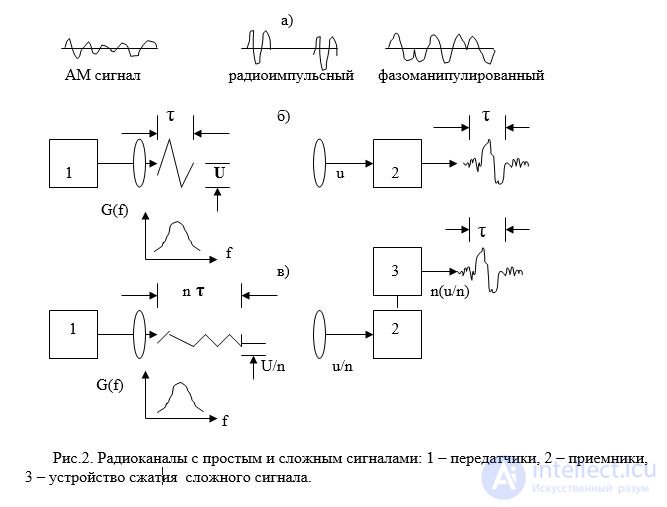Lecture
In radio engineering uses a variety of signals. These are mainly deterministic signals that have analytical forms of records. They can be simple or complex. Recently, both random (stochastic) and quasi-random have often become used. The lecture gives the basic concepts of deterministic simple and complex signals and stochastic ones.The main features of simple and complex signals
In classical radio engineering, the carrier — RF or microwave col- lection *** — was distinguished, and the signal was superimposed on the carrier information in the form of a modulating function. Today, the carrier itself can be a signal, since it can carry information about the propagation medium.
Consideration signals should start with the ones that generate the transmitters and antennas radiate into space P rimenyayutsya a variety of signals. The most common of them is still sinusoidal, even in radio pulse systems. More complex ones may have phase modulation.

Fig.2. Radio channels with simple and complex signals: 1 - transmitters, 2 - receivers, 3 - a device for compressing a complex signal.
But often such radiation powers are needed that can not be generated by modern electronic devices or transmitted via transmission lines. Then apply complex signals of lower power, but those that can be “compressed” in the receiving device and increase their amplitude as many times as it was reduced in the process of radiation. In fig. 1 shows the principle of obtaining a given signal-to-noise ratio at the output of the receiving device by these methods.
As a result, the output produces the same signal durations and signal-to-noise ratios. Despite the large pulse length in example b), the spectra of signals G ( f ) in both variants have the same width. This is a necessary condition for obtaining pulse durations in the considered example.
There is the concept of simple and complex signals. One of the main characteristics is the base B . This is the product of the width of the spectrum for the duration. Thus, the pulse signal for finite length τ and and rectangular spectral width Δ F of the first zero is equal to 1 / τ u.

Fig.3. Two signals with the same spectrum
In fig. 3 shows two examples of signals with duration τ and and τ and 1 with the same spectra and energies E and E 1 . E = U m 2 τ and , E 1 = U m 1 2 τ and 1 .
To distinguish them, they introduced the concept of a base of signals B = Δ F τ and . The base of the first signal B = (1 / τ and ) τ and = 1 . With equal spectra, the base of the second depends on its duration. If the duration is more than 10-100 times, then the base of the second signal will correspond to 10-100. If 1000 or more times, then naturally 1000 or more. Signals with a base of 1, or this order is considered to be simple. With a base significantly more than 1 - complex . Moreover, if the base is of the order of 100 or less, the complex ones are not very basic. If B > 1000, then the signal is called complex with a large base.
As illustrated above, a complex signal is created in order to compress it in time and increase the amplitude of the compressed pulse. Base signal makes it possible to predict the compression factor k SJ = B . At the same time, the amplitude of the squeezed pulse U m szh theoretically can increase as much as U m szh = B U m 1 .
In general, the signal can be not only deterministic, but also stochastic. To obtain the spectrum U ( f ) of a deterministic signal, it suffices to have an analytical record of the signal function u ( t ). Conversely, if the complex spectrum is known, u ( t ) can be calculated . As is known, these links are displayed by a pair of Fourier transforms, where in general the spectrum is a complex value having a real modulus of the spectrum (envelope) and its phase response:
 ∞ ∞
∞ ∞
U ( f ) = ∫ u ( t ) ( exp - ωt ) dt ; For symmetric signals, U ( f ) = ∫ u ( t ) Cos ( ωt ) dt
-∞ -∞
∞ 
u ( t ) = ∫ U ( f ) ( exp ωt ) df ; It is impossible to calculate the signal modulo the spectrum.
-∞
Here is the format of the V / Hz spectrum . This is the stress spectrum. Although the spectrum module can be represented on the power scale of W / Hz.
Comments
To leave a comment
Radio Engineering Systems
Terms: Radio Engineering Systems